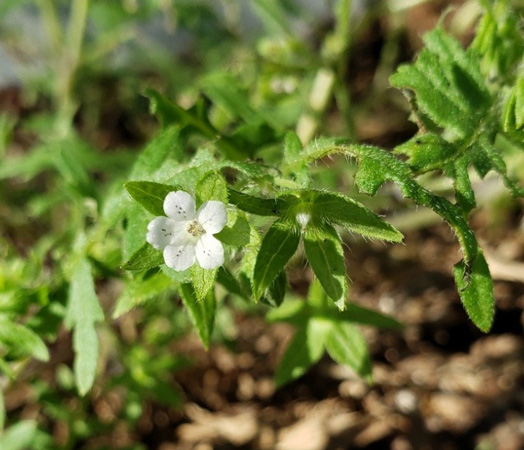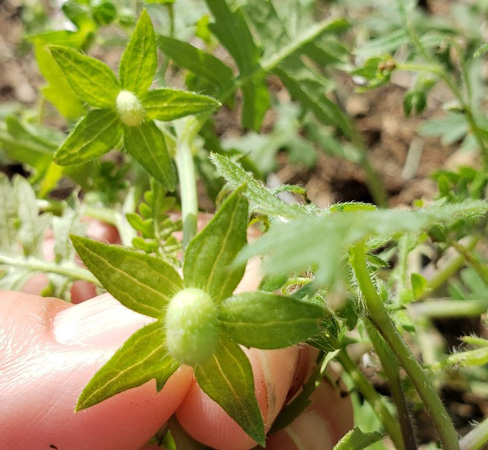A photo was recently submitted of an “unfamiliar” weed that was found while scouting a field. The weed was identified as waterpod (Ellisia nyctelea). Waterpod is a member of the same botanical family a corn gromwell and is also called Aunt Lucy.
Ecology
Waterpod is an annual weed that is native to North America. It can be found throughout Kansas across a range of soils, often in the shaded, moist soils of open forests. It is also found in shady lawns that are poorly maintained.
Identification
Waterpod emerges in early spring with oblong cotyledons. The first leaves are opposite, but leaves become alternately arranged along the stem. They are oblong, about 1 to 3 inches long, with deep lobes that create 5 to 13 segments (Figure 1). Both leaf surfaces are covered in bristly hairs. Stems reach approximately 4 to 20 inches long and are bristly and angled, with many branches. Waterpod has a weak taproot.

Figure 1. Waterpod growing in wheat stubble. Note the many branches and deeply lobed leaves. Photo by Sarah Lancaster, K-State Research and Extension.
Single bell-shaped flowers, approximately 3/8 inch long, are produced opposite leaves or at the branches along the stem. Flowers have 5 white to lavender petals with dark purple spots and purple veins. Beneath each flower is a leaf-like calyx with 5 pointed lobes covered in bristly hairs. Four dark brown, spherical seeds approximately 1/10 inch long are contained in round capsules that are about ¼ inch long and covered in bristly hairs.

Figure 2. Waterpod flower with purple spots on petals. Photo by Sarah Lancaster, K-State Research and Extension.

Figure 3. Waterpod capsule and calyx. Photo by Sarah Lancaster, K-State Research and Extension.
Management
Waterpod is generally not competitive with crops. Prior to summer crops, it is controlled by field preparation such as tillage or burndown applications that include herbicides like glyphosate and 2,4-D.
The use of trade names is for clarity to readers and does not imply endorsement of a particular product, nor does exclusion imply non-approval. Always consult the herbicide label for the most current use requirements.
Sarah Lancaster, Extension Weed Management Specialist, Manhattan
slancaster@ksu.edu
Jeanne Falk Jones, Multi-County Agronomist
jfalkjones@ksu.edu